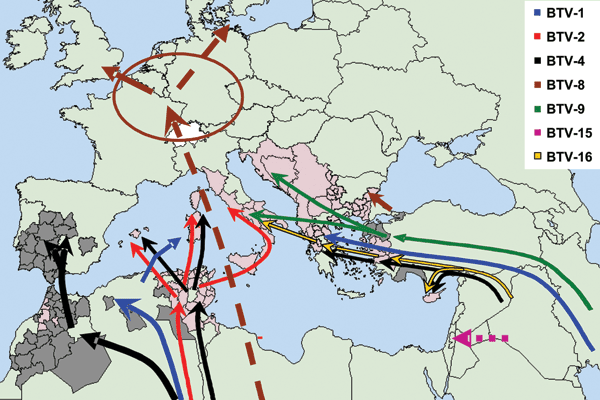Cornell-Israel collaboration works backwards to fight virus threatening livestock trade worldwide
European livestock beware: bluetongue virus is coming your way, and it’s deadlier than ever. Once limited to warmer climes, the insect-borne virus’s new highly pathogenic strain has been spreading northward since 2006, reaching farther into Europe than ever before. Bluetongue’s rise threatens ruminants and the industries depending on them. Sheep and deer suffer most, developing dangerously high fevers, swollen mouths, and occasionally the disease’s signature blue tongue. Most infected sheep and deer die; other ruminants (cattle, goats, camels, buffalo, and antelopes) show milder symptoms but can carry the disease, further enabling its spread.
Illnesses, deaths, and international trade restrictions due to bluetongue have cost the world economy billions, including the United States, whose more benign strains still hinder livestock-related exports to bluetongue-free countries. Vaccines work weakly at best: with 25 separate strains each needing yearly updates, the quickly-evolving bluetongue virus seems to defy defense.
In the arms race between virus and victim, human knowledge is catching up. Dr. John Parker, virologist at Cornell University College of Veterinary Medicine’s Baker Institute for Animal Health, has joined Israeli microbiologist Dr. Marcelo Ehrlich of the University of Tel Aviv to learn what makes bluetongue tick, unlocking the inner workings of its deadliest strain with discoveries that could help in designing a lasting universal vaccine.
“No one thought bluetongue would spread this far, and with current vaccines even the most watchful countries can’t protect themselves from it,” said Parker. “Insects carrying bluetongue don’t respect national borders, and climate change has let them expand their range. Meanwhile this new strain is especially virulent: good at bursting through cells to infect new ones. If we can learn how bluetongue kills cells and why this strain is so good at it, we may be able to better control its spread.”
When bluetongue invades a cell it creates a protein called NS3, reproduces, and eventually bursts through the cell. All strains produce NS3, but the more virulent strains produce an altered form. When experiments in Israel suggested NS3 helps degrade cells so the virus can escape, Ehrlich contacted Parker, a former collaborator, who studies cell death.
The pair has created a novel plasmid-based system to discover exactly what NS3 does using reverse genetics. While standard “forward” genetics start with a trait then look for the genes influencing it, recently developed “reverse” genetics systems manipulate specific genes to look for their effects. Parker and Ehrlich are making mutant bluetongue viruses that alter NS3 to see what it does in a cell.
“Reverse genetics has become the gold standard for doing molecular virology,” said Parker. “It’s particularly useful for studying specific proteins. But until recently it was very difficult to develop these systems for reoviruses, the family to which bluetongue belongs.”
In 2006 one of Parker’s collaborators created a new reverse genetics system that uses plasmids, easily copied pieces of bacterial DNA, to insert viral mutants directly into cells, skipping steps that once impeded the study of reoviruses.
“The majority of Cornell’s microbiology labs do this every day: they take plasmid DNA, mutate it, and study the effect on a protein,” said Parker. “It’s much more convenient and makes transferring genetic material between labs easier, enabling better collaboration. In Israel, where virulent bluetongue is common, Marcelo will conduct experiments that for biosecurity reasons could never be conducted in the US, where strains are relatively benign.”
The researchers took an unusual route in constructing the mutant viruses they will study: hiring a company to synthesize them from scratch.
“These days you can make a pathogen by putting in an order,” said Parker. “It was first done for Polio virus, and more and more researchers are taking this approach. It’s cheaper and faster than paying grad students to spend months cloning genes. People used to learn PCR—nowadays my lab staff learn how to place an order, making sure the DNA sequence they ask for is right.”
“Viruses are often seen as mysterious and dangerous things that are hard to control. There’s some truth to that, but we are making significant progress in our abilities to manipulate viruses in ways that help us understand them better in order to develop better vaccines and treatments.”
Their work is supported by the US-Israel Binational Agricultural Research Development (BARD) Fund, which funds collaborative research to solve agricultural problems.

The molecular epidemiology of bluetongue virus (BTV) since 1998: routes of introduction of different serotypes and individual virus strains.
—
‘Scopes Magazine
February 2012
